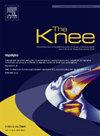Vastus medialis onset activation in patients who underwent medial patellofemoral ligament reconstruction with and without tibial tubercular osteotomy
IF 2
4区 医学
Q3 ORTHOPEDICS
引用次数: 0
Abstract
Background
Medial patellofemoral ligament reconstruction (MPFLR) and tibial tubercular osteotomy (TTO) are common surgical treatments for patellar dislocation. However, the impact of isolated MPFLR and MPFLR combined with TTO (MPFLR+TTO) on vastus medialis oblique (VMO) onset activation remains unclear. This study investigated the VMO onset activation relative to the vastus lateralis (VL) among patients undergoing isolated MPFLR, MPFLR+TTO, and healthy controls during maximum voluntary isometric knee extension.
Methods
This study included 25 patients who underwent MPFLR, divided into two groups: isolated MPFLR (n = 12, age: 22.6 ± 11.9, follow-up time: 24.0 ± 16.8 months) and MPFLR+TTO (n = 15, age: 28.2 ± 12.8, follow-up time: 25.2 ± 15.6 months). A control group of 11 healthy adults (22 knees, age: 28.4 ± 1.3) was also included. Electromyographic (EMG) activities of the VMO and VL muscles were recorded during maximal voluntary isometric knee extensions at 30°, 60°, and 90° of flexion. Differences in VMO onset activation relative to VL (VMO-VL) were analyzed.
Results
At 30° knee flexion, the MPFLR group showed a significant delay in VMO activation compared to healthy controls (p < 0.001). In contrast, the MPFLR+TTO group exhibited no significant differences in VMO activation relative to healthy controls. No significant differences were observed at 60° and 90° flexion among all groups.
Conclusion
Isolated MPFLR delayed VMO activation relative to VL. In contrast, MPFLR+TTO balanced the onset activation between VMO and VL. These findings highlight the need for targeted rehabilitation programs to address delayed VMO activation in patients undergoing isolated MPFLR.
接受内侧髌股韧带重建伴或不伴胫骨结核截骨的患者的股内侧肌开始激活
髌股内侧韧带重建术(MPFLR)和胫骨结核截骨术(TTO)是治疗髌骨脱位的常用手术方法。然而,孤立MPFLR和MPFLR联合TTO (MPFLR+TTO)对股内侧斜肌(VMO)发病激活的影响尚不清楚。本研究调查了孤立性MPFLR、MPFLR+TTO患者和健康对照者在最大自主等距膝关节伸展期间相对于股外侧肌(VL)的VMO起始激活。方法将25例MPFLR患者分为单纯MPFLR组(n = 12,年龄:22.6±11.9,随访时间:24.0±16.8个月)和MPFLR+TTO组(n = 15,年龄:28.2±12.8,随访时间:25.2±15.6个月)。健康成人11例(22膝,年龄28.4±1.3岁)作为对照组。在屈曲30°,60°和90°的最大自主等距膝关节伸展时,记录VMO和VL肌肉的肌电图(EMG)活动。分析VMO与VL的起始激活差异(VMO-VL)。结果在膝关节屈曲30°时,与健康对照组相比,MPFLR组VMO激活明显延迟(p <;0.001)。相比之下,MPFLR+TTO组在VMO激活方面与健康对照组没有显著差异。60°和90°屈曲组间无显著差异。结论离体MPFLR相对于VL延迟VMO的激活。相比之下,MPFLR+TTO平衡了VMO和VL之间的起始激活。这些发现强调需要有针对性的康复计划来解决孤立性MPFLR患者延迟的VMO激活。
本文章由计算机程序翻译,如有差异,请以英文原文为准。
求助全文
约1分钟内获得全文
求助全文
来源期刊

Knee
医学-外科
CiteScore
3.80
自引率
5.30%
发文量
171
审稿时长
6 months
期刊介绍:
The Knee is an international journal publishing studies on the clinical treatment and fundamental biomechanical characteristics of this joint. The aim of the journal is to provide a vehicle relevant to surgeons, biomedical engineers, imaging specialists, materials scientists, rehabilitation personnel and all those with an interest in the knee.
The topics covered include, but are not limited to:
• Anatomy, physiology, morphology and biochemistry;
• Biomechanical studies;
• Advances in the development of prosthetic, orthotic and augmentation devices;
• Imaging and diagnostic techniques;
• Pathology;
• Trauma;
• Surgery;
• Rehabilitation.
 求助内容:
求助内容: 应助结果提醒方式:
应助结果提醒方式:


